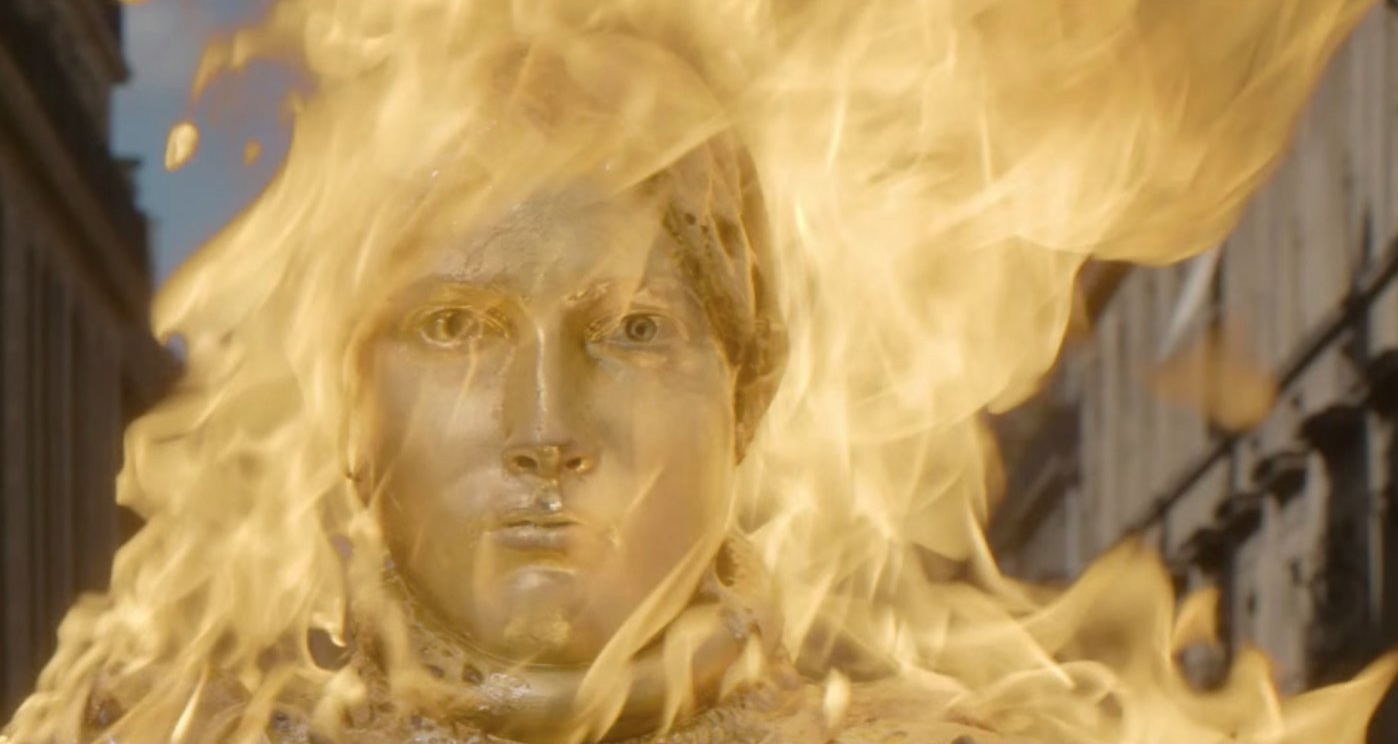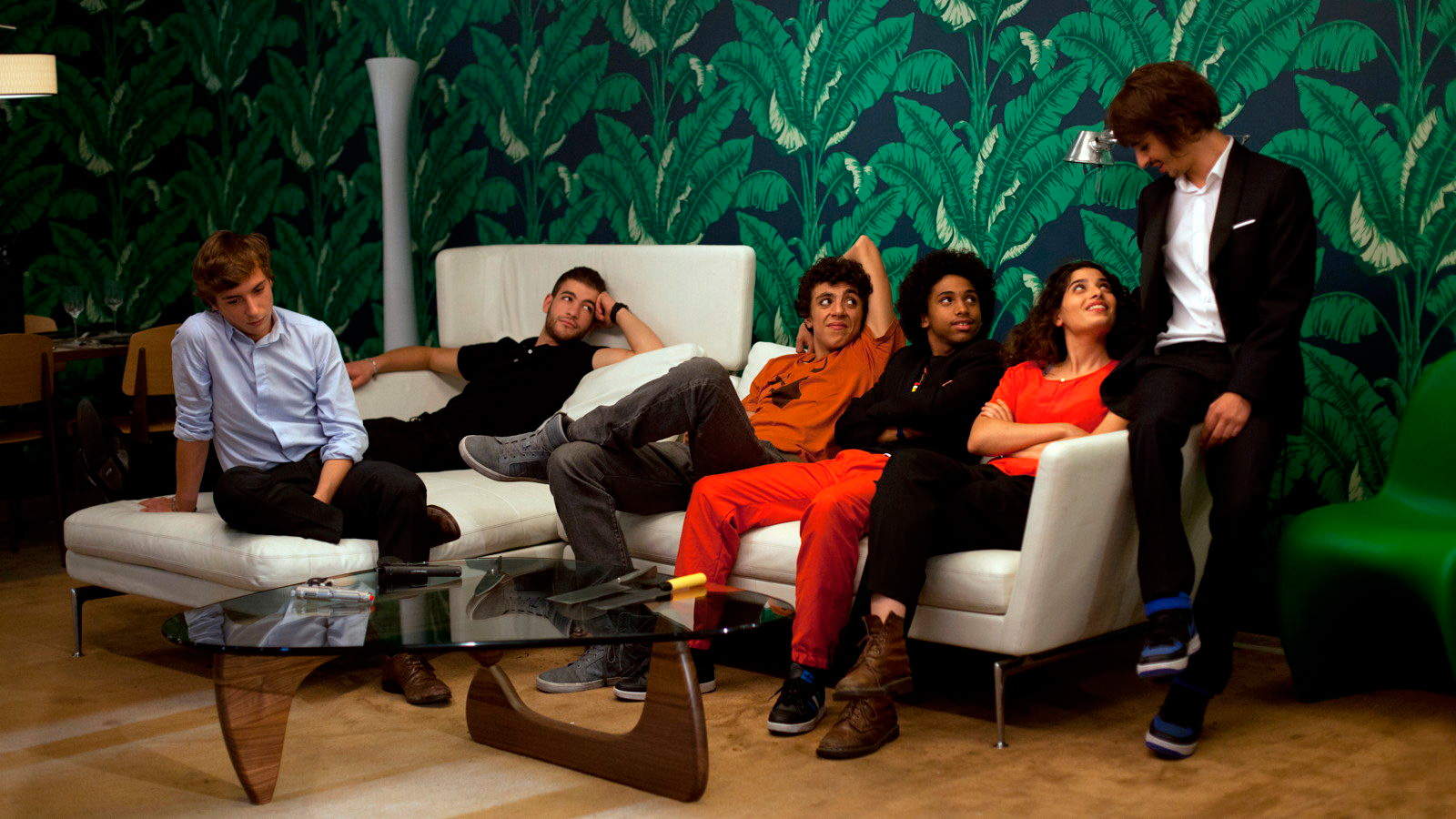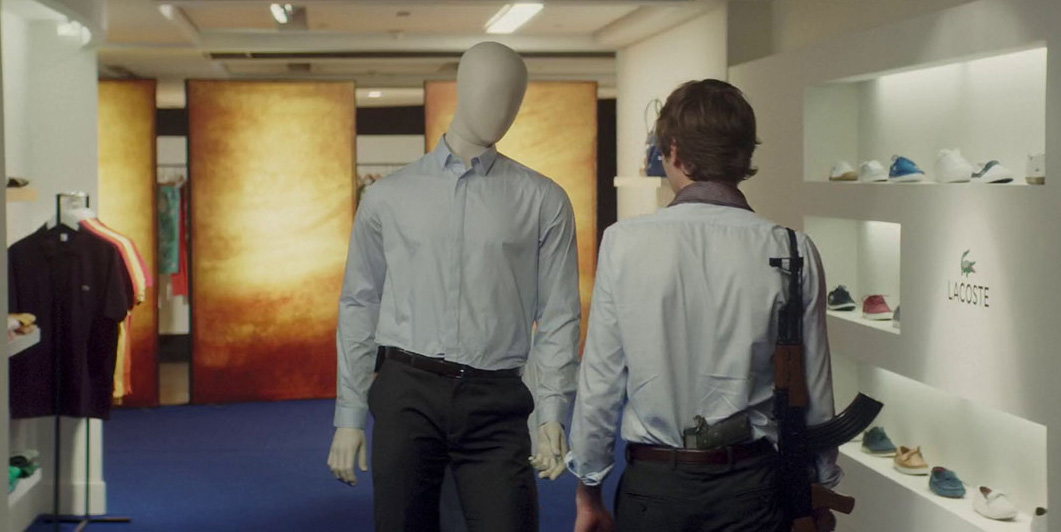A shabby-chic cadre of photogenic young Parisians coordinate a series of terrorist attacks, blowing up or setting fire to buildings and monuments throughout the city, then take refuge after nightfall in an empty department store. Nocturama, the French filmmaker Bertrand Bonello’s daring and controversial follow-up to his 2014 Yves Saint Laurent biopic, is even more relentlessly stylish than its predecessor—an abstract thriller predicated on its young characters’ fantasies of taking revenge on the system and, less consciously perhaps, of liberating its largesse. The terrorists are ciphers but the movie is only superficially shallow. At once timely and timeless, it sets the aftermath of two centuries of French history to a hypnotic, trancelike beat.
In its use of music (Willow Smith’s “Whip My Hair” plays over one scene), surveillance video (the department store is filled with security cameras and TV monitors), and fashion (the fugitives raid the store’s clothing section), Nocturama feels effortlessly contemporary. Still, the ghosts of the past are always present, both by implication and as visual reference to a painting or monument: the French Revolution; the July 1830 overthrow of Charles X; La Commune; the Bonnot Gang; the OAS; May 1968; Islamic jihad.
So are movies. Among many other films, Nocturama makes reference to the affectless young cast of Robert Bresson’s The Devil Probably, the shopping mall setting of George Romero’s Dawn of the Dead, and The New Babylon, a Soviet silent set in 1870s Paris that juxtaposes revolutionary zeal with consumerist decadence.
Bonello says that he conceived Nocturama while working on his 2011 evocation of a luxurious Belle Époque bordello, released in the US as House of Pleasures. The movie began shooting before the Charlie Hebdo-Hypercacher massacre of January 2015 and was in post-production in the following November during the attack on the Bataclan concert hall. As a result, Bonello changed the film’s name from the insolent Paris est une fête (“Paris Is a Party”) to the more hallucinatory Nocturama.
The title is borrowed from an album by the singer Nick Cave, but when Nocturama opened in Paris to mixed but generally favorable reviews last summer (a month after the Bastille Day attack on the beach at Nice), several critics saw a link to Bret Easton Ellis’s 1998 Glamorama. In that five-hundred-page novel (evidently more highly regarded in France than here), Ellis imagines a rebellion of the mannequins—high-fashion supermodels form a terrorist organization. Bonello’s characters are mannequins as well—their cell is perhaps two members short of a Benetton ad—but as his movie makes clear they are more victims than victimizers of fashion, unpaid billboards for the designer labels they wear.
The cell has a marked, non-negotiable class structure. Three, perhaps four, of the members—the brains of the outfit—are students at Sciences Po, France’s default leadership school. One of them makes the modish assertion that “perfect democracy” creates its own enemy, meaning himself. Another four, including a brother and sister, are implied to be of North African origin, living in a banlieue northeast of Paris. One, Yacine (Hamza Meziani), who is the first character we see, works in a café frequented by Sciences Po students and is presumably a bridge between these two worlds—the over- and the underprivileged. Two other members, or perhaps accomplices, are young security men, renegade agents of order, one employed in an office tower in La Défense, the other in the nameless emporium in which the gang takes shelter. (That five of the terrorists might have Islamic backgrounds scarcely seems relevant, although one of them does have a vague idea that acts of terror might offer a heavenly reward—a notion he abandons when he actually faces death.)
For slightly less than an hour, Nocturama is abuzz with purposeful, if enigmatic, activity as individual members of the terror cell meet and regroup on the metro, crisscrossing the city to gain access to various buildings, plant plastic bombs, and, in one case, carry out an assassination. It’s easy to be swept up in the action, which is interspersed with helpful (or confusing) flashbacks, but hard to parse it.
Individual identities are somewhat fluid. Sabrina (Manal Issa) is coached by her brother Samir (Ilias Le Doré) to book a four-hundred-euro-a-night room at the posh Hotel Regina, where she idly watches a music video not so different in texture from Nocturama itself. She uses the room as a staging ground to dress as a uniformed city worker and then cover the nearby equestrian statue of Joan of Arc with some sort of flammable fluid, which will later be ignited. Her impassive exchange of glances with France’s savior is one of the movie’s crucial shots.
Advertisement
At precisely 5:15 PM, Paris begins exploding. We see the simultaneous detonations in a four-way split-screen shot that approximates the surveillance feeds in the store where the cell regroups. Bonello uses the long-empty La Samaritaine for the building’s exteriors; many of the interiors appear to have been shot in or modeled after Le Bon Marché, the world’s first department store or, perhaps we should say, shopping mall. It is in this vast temple of consumerism that the cell’s comportment goes from alarming competence to random self-indulgence, verging on madness.
As demonstrated in Saint Laurent, Bonello is a master of mise-en-scène. Here his fluid camera emphasizes the cell members luxuriating in commodities even as the brisk cutting-on-motion of the first half emphasized the caper-like action of the attack itself. The store is a material dream: the children dress up, listen to rap, watch the news on multiple monitors, play with toys, and even invite a homeless couple to come in and play as well. (It’s a mordant joke that the most privileged of the group screams in shock when the couple ascends on the escalator as if entering paradise.) Mannequins are ubiquitous. In the movie’s signature shot, Yacine is brought up short confronting one such blank-faced dummy, who is wearing the exact same Nike swoosh T-shirt as he is. In its appreciation of the uncanny, Nocturama suggests a Twilight Zone episode wherein consumer objects come to life after hours. It is as if the Marx Brothers’ antic comedy The Big Store had been infused with Karl Marx’s notion of commodity fetishism.
Does Yacine recognize himself as a mannequin in the same way that the female protagonist of Blade Runner is forced to understand that she is an artificially constructed “replicant”? And is Nocturama itself, as Daniel Mendelsohn wrote of Ellis’s Glamorama, an “artifact of the culture it pretends to criticize”? France’s two most prestigious film journals, both supportive of Bonello in the past, suggested as much. Speaking for the left, Cahiers du Cinéma cited “the incredible confusion of a film claiming to grasp or even carry a seditious thought”; Michel Ciment, the editor of Positif, a magazine with roots in French surrealism, took a loftier position, dismissing Nocturama as “an irresponsible film.”
Nocturama might best be seen as a surrealist thought experiment. (“It had to happen and now it has,” a bystander observes when one member of the cell ventures out of the store, pithily articulating the film’s fatal attractions.) If these callow terrorists do not appear to have an agenda, Bonello does. Unlike other aggressively contemporary films, Nocturama does not attempt to analyze a particular reality, mediated by music videos and digital ads. Rather, it seeks to embody it. Bonello’s characters are less recognizably human than they are their own personal avatars in some advanced computer-game prototype.
House of Pleasure reached its pop apotheosis when, celebrating the dawn of the twentieth century, the tearful sex-slaves of Paris’s most luxurious brothel waltzed to The Moody Blues’s “Nights in White Satin.” Here, the big number is an extended sequence in which Yacine, in drag makeup, gives a dramatic lip-synched performance of Shirley Bassey’s histrionic version of “My Way” (a song that has since taken on an additional layer of meaning since Donald Trump chose it for his first dance at the Inaugural Ball).
The most self-actualized member of the gang, Yacine had previously driven a toy car throughout the store in a manner suggestive of Danny’s ride through the corridors of the haunted hotel in The Shining. In the minutes before the faceless automatons of the National Gendarmerie infiltrate the store he appears both as Marat in his tub (à la David) and Al Pacino’s Scarface in silk kimono, brandishing a revolver. His comrades meanwhile are blasting Blondie’s “Call Me,” revving themselves up in what the Weather Underground called a “wargasm.”
“The mall,” Bonello told the audience at the Walter Reade when Nocturama was shown there last February, “is a place where everything is possible.” That is, until the SWAT team arrives.
Bertrand Bonello’s Nocturama opens August 11 at Metrograph and Film Society Lincoln Center, with other theaters to follow.




